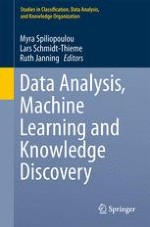Data analysis, machine learning and knowledge discovery are research areas at the intersection of computer science, artificial intelligence, mathematics and statistics. They cover general methods and techniques that can be applied to a vast set of applications such as web and text mining, marketing, medicine, bioinformatics and business intelligence. This volume contains the revised versions of selected papers in the field of data analysis, machine learning and knowledge discovery presented during the 36th annual conference of the German Classification Society (GfKl). The conference was held at the University of Hildesheim (Germany) in August 2012.
